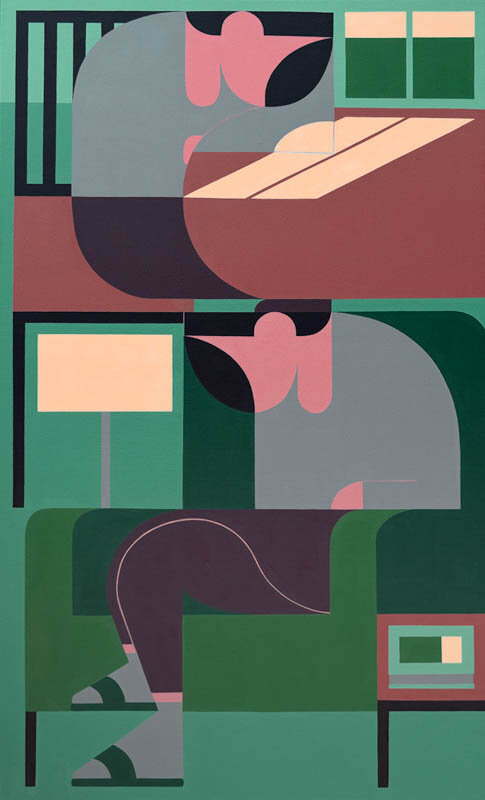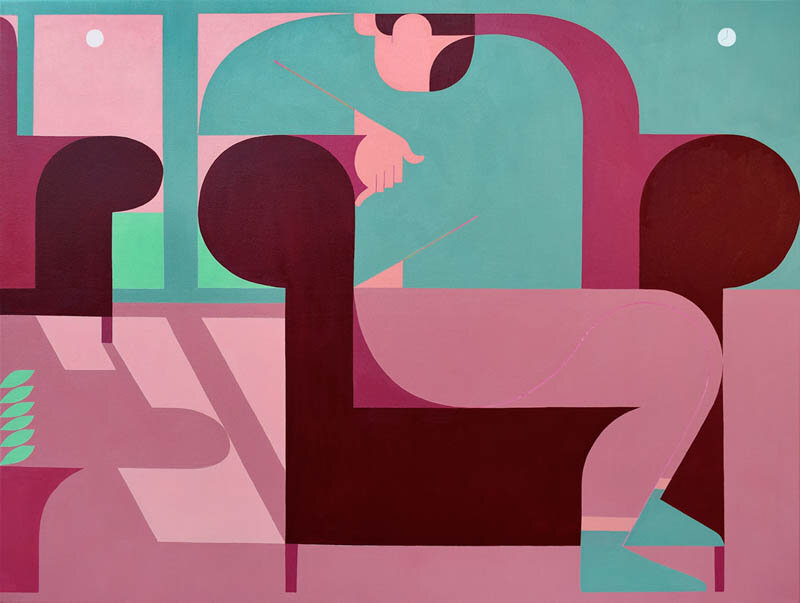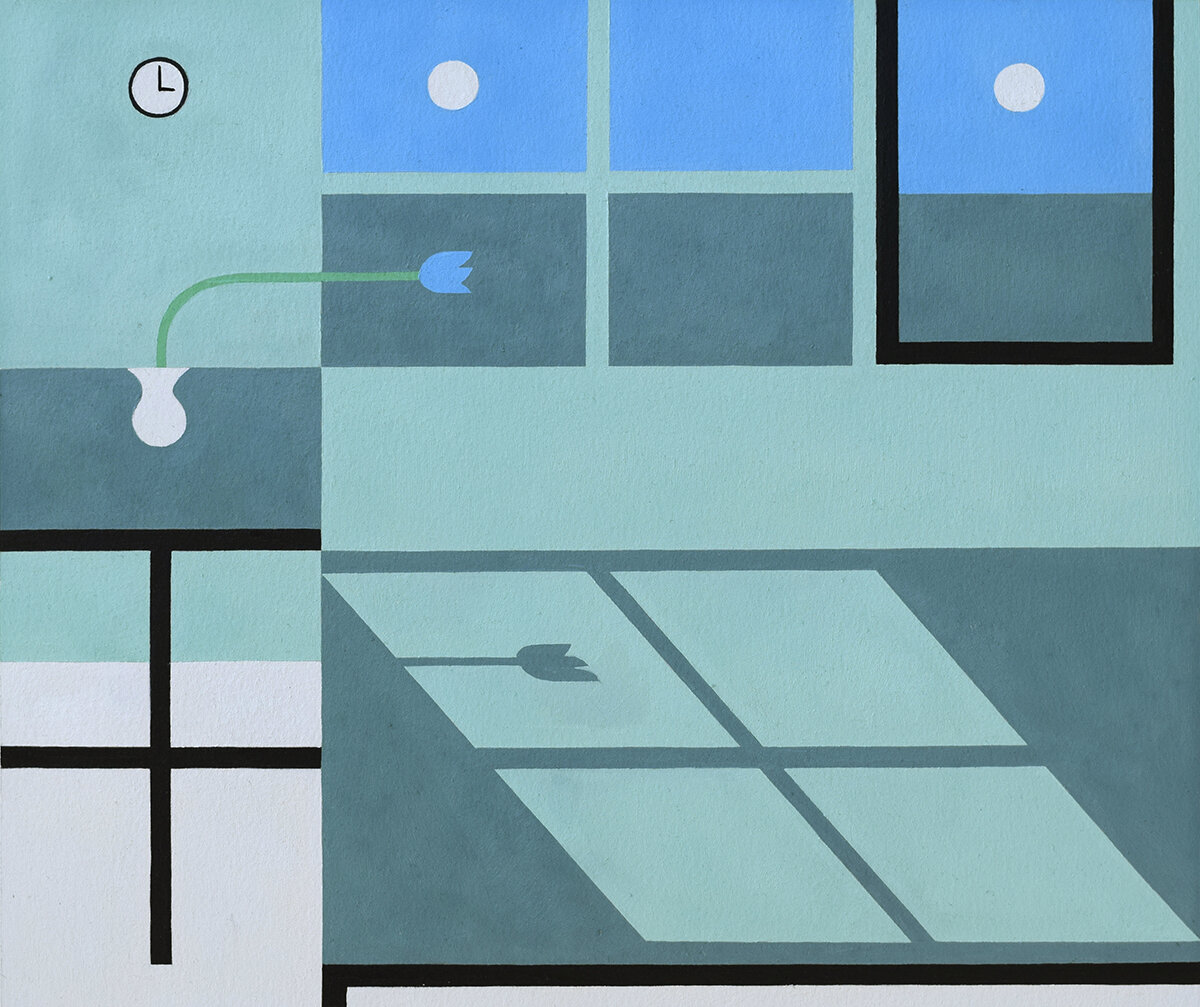Adrian Wong
Adrian Kay Wong was born and raised in the east San Francisco Bay area and now lives and works in Los Angeles, CA. after receiving his BFA from the School of the Art Institute of Chicago in 2013
Statement
Adrian Kay Wong observes the intimate and familiar by depicting daily life in isolated, encapsulated moments. Composed with a deliberate and measured simplicity, his paintings preserve a stillness that feels cohesive, sentimental, and familiar. Wong often employs a visual alliteration that manifests itself in the basic construction of his shapes, use of repeated forms, and reoccurring motifs. By segmenting his surfaces into forms that are collectively representational, but independently functioning as abstract shapes, these modular elements explore interactions between primary subject and contextual elements. Wong's puzzle-like arrangements are intensified by a flatness that subverts the usual perception of depth and visual hierarchy. The paintings are distinctive in a sensitivity to the quieter, more mundane, and ordinary settings of the everyday. Wong attempts to discover and glorify the sentimentalities in these scenes often overlooked – the sedentary, the subtle, the unnoticed.
I Could Hear the Lights Left On, 2019. Oil on Paper, 18” x 18”.
Interview with Adrian Wong
Questions by Emily Burns
Hi Adrian, Can you tell us a bit about your background and how you decided to pursue a path as an artist? Do you have any early creative memories? Are any family members artists?
Hey, great to speak with you! I sort of fell into art on a whim. I always drew and doodled when I was younger, but honestly who didn't? Later, I was basically taking art classes in school because they were easy A's. At the time, drawing, in a technical standpoint, came very naturally to me. I never intended to go to art school and it wasn't even considered until I was encouraged to apply by my teacher and aunt who took ceramics as a hobby. No one else in my family really has much involvement in art. So when it came time for college applications, I was actually opting for statistical economics as my career path.
Most of my creative memories are pretty common of everyone, like I said earlier just doodling a lot. I think a funny one that comes to mind was when my brother and I were in an art class my mother enrolled us in and we would just race to see who could complete the most drawings and paintings in one sitting. I just remember the teacher being somewhat disappointed and upset that we were both tearing through sheet after sheet of paper because we were being competitive bratty kids, while also conflictingly trying to be supportive at the same time.
Can you walk us through the process of making your paintings? Does drawing play a part in your work? Do you use any tools to help you create the clean lines of the puzzle-like shapes?
I think drawing plays the biggest role in my process. I would say I invest the most time, focus, and effort into it. It starts as a lot of sketching, then redrawing, tracing, repeating forms, and putting a great level of attention into how shapes are arranged and organized in the composition. This all takes place in the sketchbook, with relatively loose drawings becoming more and more “precise” as they're developed. Once I've completed a drawing that I'm happy with, I repeat that drawing on the canvas with use of really only a brush and a ruler.
For the clean lines, I think it'd come as a surprise to people that I don't use tape. I enjoy the idea of “intended perfection”. If viewers spend enough time looking at one of my painted lines they'll see that they're not perfect. I think it adds to the experience of the painting where initially we see exactness, but over time there is evidence of my hand in the execution of the work. I often get asked how I paint the edges and lines so cleanly and my best answer is just a lot of time and repetition.
Your recent work is similar to your earlier work overall, though the recent work feels more detailed, with more precision in the quality of the ultra flat surface of the paintings. Was this a conscious shift?
I think it was a conscious shift in the sense that I was and still am someone who's very paranoid about complacency. Every time I'd start a painting, I'd think “this one has to be the next best one I've done.” While I do think I've emerged from that with a now more exploratory sensibility, there is definitely a residual feeling of always wanting more out of myself. The level of quality that I now am able to work the flat surface of my paintings is kind of just the result of doing it over and over again just a bit better each time.
Color seems very important to you—how do you approach color in your work?
I used to be very scared of color! I've always reserved a lot of respect for it as a very pivotal part of my work. I used to paint in a much more pastel and toned down palette – mixing white into a lot of the colors I was working with. But now as I've become more comfortable and familiar with it, I'm not afraid to push the boundaries between lights and darks or intense and subdued. I definitely try to employ color purposefully and with intent.
Usually when I start painting, I approach color first in the sense of light and dark. My priority is to address the range of values that will be occupying the canvas. I enjoy working with a limited palette, so color decisions are strongly based in relation to one another – kind of like each next color choice is a result of the previous.
I often use Photoshop to help adjust color quickly, experiment with more radical color decisions, or look for different color relationships before I start painting. I also have a lot of books that I'll take reference from. On occasion, sometimes a painting will begin because a certain combination of colors evoke some sort of imagery in my head.
The figures in your work are highly geometric—comprised primarily of circles and squares that becomes a totally different language of forms and 3-dimensional space. Have you always made images using a similar system? How did this come about?
Looking back, I really believe that my abstraction and simplification of form was a coping mechanism when I first moved to Los Angeles in 2013. It was a part of my life that was very difficult for me and it was a way for me to process a new environment where I was essentially beginning a new life after graduating college.
From that point, it was a process of finding a visual language that eventually shifted to what is now a methodology of balancing abstraction and representation where forms can both act independently as interesting color shapes, but also function as a part of a specific thing.
When I was younger – as in middle school and high school – I was really into hyperrealistic pencil drawings and I do think that certain type of intensity is carried over to my current work. I have this extreme need for some sort of organizational system. Many of the forms in my paintings share the same method of representation: they're parallel to one another, they curve in the same way, the corners meet at the same specific point, etc. It creates a sort of cohesiveness that allows viewers' eyes to move through the painting.
Boketto, 2019. Oil on Canvas, 40” x 40”.
Are the figures in your work the same characters repeated throughout your series? Are there any particular narratives in mind for each painting?
You know, the repeated figure motif started as a reference to my brother and I. We're twins so not only are we the same age and look very alike, but we essentially have lived almost the same life as well. This was a very interesting relationship that I wanted to explore. Painting two of the same figure exactly next to each other created a weirdly engaging and interesting spatial interaction. This eventually extended itself beyond the figures, morphing into an interest in representing things that can reference both literally and metaphorically.
So while they're not the same characters being repeated throughout my series, there is often someone from my personal life that I translate into my painted figures. Inevitably, these people carry certain narratives with them which sometimes drive the subject matter of the paintings. Some are more specific than others and can range from nostalgic memories to stories of today.
You often describe domestic spaces, still life, or mundane, everyday moments of quiet and repose. can you talk about the mood you hope to create in your work?
It's always hard for me to describe this feeling with words. I mean I can use words like melancholic, quiet, sentimental, but they aren't really super accurate. The best example I can give is that it's like a memory of when you're a kid and you wake up in the middle of the night. You walk to the kitchen to grab some water and on the way back you pass your parent's room and catch a glimpse of your dad watching TV alone. There's a subtle buzz from the TV, some quiet, incomprehensible chattering from the show, and an illuminating glow that barely lights the room and his face. And all of that happens in like half a second when you glance into the room. It's that type of moment. On paper, pretty forgettable, but these unnoticed moments characterize every day of our lives and yet we miss them time after time.
It's a little bit of nostalgia, sadness, emptiness, isolation, but usually without the negative connotations to these ideas. Or even easier, I could ask, “Why are sunsets so nice to look at?” The circle in the sky goes down slowly and the colors change. Literally, that's all it is, but at the same time it contains many romantic implications and some of us find ourselves just staring and appreciating it for what I would guess is a very complex simplicity.
Are there any other themes that are at the forefront of your mind right now?
Recently, I've been reevaluating my approach to color values. I've been visualizing light as an object, a motif, a kind of visual “piece”. So most clearly, by extending the range of dark and light, there is more opportunity for interesting spatial interactions. Also, the introduction of this visual element that can further divide painted areas can result in more tessellations of shapes and color. All of this in turn affects our perception of narratives and events occurring in the painting.
What is a typical day like for you?
I try to start early, usually getting up around 7 or 8 and starting to work at 8:30 or 9. What I'm working on can range from drawing in my sketchbook all day to painting or canvas preparation or other projects. Sometimes I'll be stepping out for a meeting or talk over coffee, but most often than not I like to hole myself in the studio. What I try to maintain focus in for each day is to work for 10 hours with as little interruption as possible. Usually days end around 8 or 9, or if I'm really grinding I may end at 11 or 12 or even into the morning hours. Sprinkle some emails here and there, a couple meals, and little distractions throughout the day and it basically summarizes 90% of my life.
Can you tell us about your studio? What do you need to be productive there?
I work out of my home studio, which is a decently-sized room dedicated to my practice. I have a need for immediacy and access to my work, but much of the subject matter that I explore falls into the conversation of residence, home, and intimate spaces. Along with other factors, I've found that I much rather prefer to work in an environment that feels unique and personal to me than a “studio” that is more artificial and generic.
Do you prefer to be energetic and upbeat or calm and reflective when working? How do you cultivate the mood in the studio?
Definitely the latter. I enjoy a certain level of solitude and usually have a podcast or music on. Because I work in my own home, much of the walls are either my own paintings or decorated with things of personal significance or that are related to my interests. So no matter where you look it's some sort of capsule to who I am. Oh, and a lot of plants.
What is one of the most exciting or interesting exhibitions you have seen recently?
I recently went to the pt.2: LA group show in Chinatown that were all paintings and I just found each one knocking out of the park respectively. Many of these artists in the show I found through people I follow on Instagram so it was exciting to see the work in person. I'm currently eyeing Do Ho Suh's installation at LACMA and am pretty excited to experience that.
Who are some of the artists you look at most often?
The names change constantly depending on what I'm working on and what part of my practice I feel like I need to dial in on, but as of recent some Helen Lundeberg, Diebenkorn, and a couple giants like Albers and Matisse. Flipping through the notes of my sketchbook are names like Felix Vallotton, Leif Kath, and a pretty obscure Japanese artist by the name of Toshio Arimoto.
Whats up next for you?
This past summer has been filled with a lot of special projects including some murals, an 80+ foot installation, and other various work so I'm happy that I've brought those to a close and have been able to devote most of my time now to making work for myself. I have a couple shows coming up in 2020 that I'm preparing for so stay tuned!
Thanks so much for taking the time to talk with us!
Thanks for the opportunity!
To find out more about Adrian and his work check out his website.






